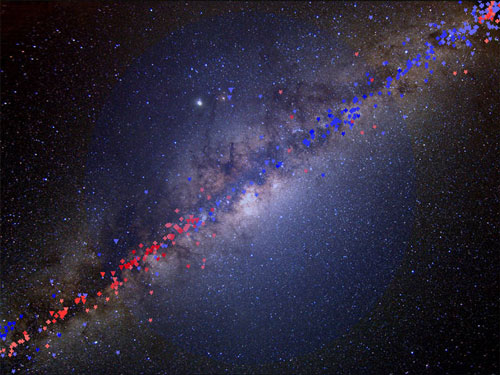| Feb 09, 2015 |
Dark matter at the heart of our Galaxy
|
|
(Nanowerk News) The Universe is pervaded by a mysterious form of matter, dubbed dark matter, about five times more abundant than the ordinary matter – made of atoms – we are familiar with. Its existence in galaxies was robustly established in the 1970s. Scientists now obtained for the first time a direct observational proof of the presence of dark matter in the innermost part our Galaxy, the Milky Way.
|
|
The ubiquitous presence of dark matter in the universe is today a central tenet in modern cosmology and astrophysics. Its existence in galaxies was robustly established in the 1970s with a variety of techniques, including the measurement of the rotation speed of gas and stars, which provides a way to effectively 'weigh' the host galaxy and determine its total mass. These measurements showed that the visible matter only accounts for a fraction of the total weight, the predominant part is delivered by dark matter.
|
 |
| View towards the center of our Galaxy with the rotation curve tracers. (Background photo: Serge Brunier/NASA)
|
|
Applying this technique to our own Galaxy is possible, and the existence of dark matter in the outer parts of the Milky Way is well ascertained. But up to now it has proven very difficult to establish the presence of dark matter in the innermost regions.
|
|
The diameter of our Galaxy is about 100,000 lightyears. Our Solar System is located at a distance of about 26,000 light years from the center. Coming closer to the center of our galaxy it becomes increasingly difficult to measure the rotation of gas and stars with the needed precision.
|
|
Dark matter in our cosmic neighborhood
|
|
Now scientists from the Technische Universität München (TUM), Stockholm University, Universidad Autónoma de Madrid, ICTP South American Institute for Fundamental Research, São Paulo and University of Amsterdam have obtained for the first time a direct observational proof of the presence of dark matter in the innermost part the Milky Way, including at the Earth’s location and in our own ‘cosmic neighborhood’ (Nature Physics, "Evidence for dark matter in the inner Milky Way").
|
|
In a first step they created the most complete compilation of published measurements of the motion of gas and stars in the Milky Way. Then they compared the measured rotation speed with that expected under the assumption that only luminous matter exists in the Galaxy. The comparison clearly showed that the observed rotation cannot be explained unless large amounts of dark matter exist around us, and between us and the galactic center.
|
|
“We know that dark matter is needed in our Galaxy to keep the stars and gas rotating at their observed speeds,” says Dr. Miguel Pato, who conducted the analysis at TU München. “However, we still do not know what dark matter is composed of. This is one of the most important science questions of our times.”
|
|
More reliable predictions
|
|
Possessing a very strong statistical evidence, even at small galactocentric distances, the results open a new avenue for the determination of dark matter distribution inside the Galaxy. With future astronomical observations, the method will allow to measure the distribution of dark matter in our Galaxy with unprecedented precision.
|
|
“This will permit to refine the understanding of the structure and evolution of our Galaxy. And it will trigger more robust predictions for the many experiments worldwide that search for dark matter particles,” says Miguel Pato, who meanwhile moved to The Oskar Klein Centre for Cosmoparticle Physics at the Stockholm University.
|

